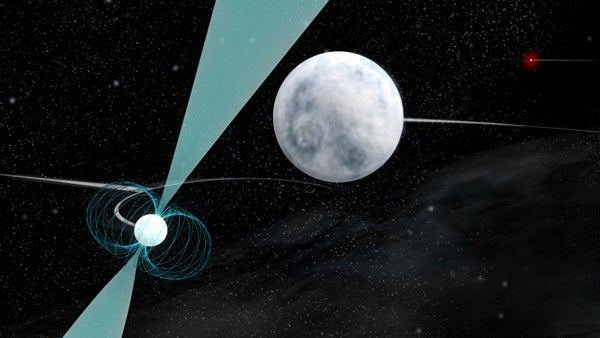The necessary data came from an intensive observational program using several of the world’s largest radio telescopes: the GBT, the Arecibo radio telescope in Puerto Rico, and ASTRON’s Westerbork Synthesis Radio Telescope in the Netherlands.
All three stars orbit each other in a space smaller than Earth’s orbit around the Sun. This close proximity, combined with the fact that all three stars are much denser than our Sun, provides the necessary conditions to test the true nature of gravity — in particular, the “strong equivalence principle” postulated in Einstein’s theory of general relativity. “This triple star system gives us the best-ever cosmic laboratory for learning how such three-body systems work and potentially for detecting problems with general relativity, which some physicists expect to see under such extreme conditions,” said Scott Ransom of the National Radio Astronomy Observatory (NRAO) in Charlottesville, Virginia.
Jason Boyles from West Virginia University originally uncovered the millisecond pulsar — some 4,200 light-years from Earth, spinning nearly 366 times per second — as part of a large-scale search for pulsars with the GBT. To use the pulsar as a gravity probe, the astronomers needed to record as many of its pulses as possible. Then, by measuring how the “tick of the pulsar clock” varied with time, they were able to determine the orbital geometry and the masses of the three stars.
“It was a monumental observing campaign,” said Jason Hessels of ASTRON in the Netherlands. “For a time, we were observing this pulsar every single day just so we could make sense of the complicated way in which it was moving around its two companion stars.”
While the astronomers were busy processing hundreds of terabytes of data, they were also building a precision model of the system. “Our observations of this system have made some of the most accurate measurements of masses in astrophysics,” said Anne Archibald from ASTRON. “Some of our measurements of the relative positions of the stars in the system are accurate to hundreds of meters, even though these stars are about 10,000 trillion kilometers from Earth.” Archibald led the effort to use the measurements to build a computer simulation of the system that can predict its motions. Archibald and the team used techniques dating back to those developed by Isaac Newton to study the Earth-Moon-Sun system, combined with the “new” gravity of Albert Einstein, which was required to make sense of the data. Moving forward, the system gives the scientists the best opportunity yet to discover a violation of a concept called the strong equivalence principle. This principle is an important aspect of the theory of general relativity and states that the effect of gravity on a body does not depend on the nature or internal structure of that body.
Two famous illustrations of the equivalence principle are Galileo’s reputed dropping of two balls of different weights from the Leaning Tower of Pisa (possibly an apocryphal story) and Apollo 15 Commander Dave Scott’s dropping of a hammer and a falcon feather while standing on the airless surface of the Moon in 1971. Lunar laser ranging measurements, using mirrors left on the Moon by the Apollo astronauts, currently provide the strongest constraints on the validity of the equivalence principle. Here the experimental masses are the stars themselves, and their different masses and gravitational binding energies will serve to check whether they all fall toward each other according to the strong equivalence principle or not. “Using the pulsar’s clocklike signal, we’ve started testing this,” Archibald said. “We believe that our tests will be much more sensitive than any previous attempts to find a deviation from the strong equivalence principle.”
“We’re extremely happy to have such a powerful laboratory for studying gravity,” Hessels said. “Similar star systems must be extremely rare in our galaxy, and we’ve luckily found one of the few!”










